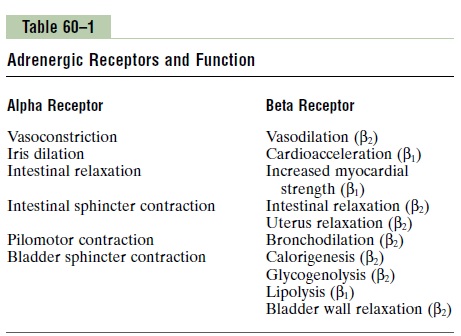Chapter: Medical Physiology: The Autonomic Nervous System and the Adrenal Medulla
Receptors on the Effector Organs
Receptors on the Effector Organs
Before an acetylcholine, norepinephrine, or epinephrine secreted at an autonomic nerve ending can stim-ulate an effector organ, it must first bind with specific receptors on the effector cells. The receptor is on theoutside of the cell membrane, bound as a prosthetic group to a protein molecule that penetrates all the way through the cell membrane. When the transmitter sub-stance binds with the receptor, this causes a confor-mational change in the structure of the protein molecule. In turn, the altered protein molecule excites or inhibits the cell, most often by (1) causing a change in cell membrane permeability to one or more ions or (2) activating or inactivating an enzyme attached to the other end of the receptor protein where it pro-trudes into the interior of the cell.
Excitation or Inhibition of the Effector Cell by Changing Its Membrane Permeability. Because the receptor proteinis an integral part of the cell membrane, a conforma-tional change in structure of the receptor protein often opens or closes an ion channel through the interstices of the protein molecule, thus altering the permeability of the cell membrane to various ions. For instance, sodium and/or calcium ion channels frequently become opened and allow rapid influx of the respective ions into the cell, usually depolarizing the cell membrane and exciting the cell. At other times, potassium channels are opened, allowing potas-sium ions to diffuse out of the cell, and this usually inhibits the cell because loss of electropositivepotassium ions creates hypernegativity inside the cell. In some cells, the changed intracellular ion environ-ment will cause an internal cell action, such as a direct effect of calcium ions to promote smooth muscle contraction.
Receptor Action by Altering Intracellular “Second Messenger” Enzymes. Another way a receptor often functions is toactivate or inactivate an enzyme (or other intracellu-lar chemical) inside the cell. The enzyme often is attached to the receptor protein where the receptor protrudes into the interior of the cell. For instance, binding of norepinephrine with its receptor on the outside of many cells increases the activity of the enzyme adenylyl cyclase on the inside of the cell, and this causes formation of cyclic adenosine monophos-phate (cAMP). The cAMP in turn can initiate any oneof many different intracellular actions, the exact effect depending on the chemical machinery of the effector cell.
It is easy to understand how an autonomic trans-mitter substance can cause inhibition in some organs or excitation in others. This is usually determined by the nature of the receptor protein in the cell mem-brane and the effect of receptor binding on its con-formational state. In each organ, the resulting effects are likely to be entirely different from those in other organs.
Two Principal Types of Acetylcholine Receptors—Muscarinic and Nicotinic Receptors
Acetylcholine activates mainly two types of receptors. They are called muscarinic and nicotinic receptors. The reason for these names is that muscarine, a poison from toadstools, activates only muscarinic receptors and will not activate nicotinic receptors, whereas nico-tine activates only nicotinic receptors; acetylcholine activates both of them.
Muscarinic receptors are found on all effector cells that are stimulated by the postganglionic cholinergic neurons of either the parasympathetic nervous system or the sympathetic system.
Nicotinic receptors are found in the autonomic ganglia at the synapses between the preganglionic and postganglionic neurons of both the sympathetic and parasympathetic systems. (Nicotinic receptors are also present at many nonautonomic nerve endings—for instance, at the neuromuscular junctions in skeletal muscle.)
An understanding of the two types of receptors is especially important because specific drugs are fre-quently used as medicine to stimulate or block one or the other of the two types of receptors.
Adrenergic Receptors—Alpha and Beta Receptors
There are also two major types of adrenergic recep-tors, alpha receptors and beta receptors. (The beta receptors in turn are divided into beta1 and beta2 recep-tors because certain chemicals affect only certain beta receptors. Also, there is a division of alpha receptors into alpha1 and alpha2 receptors.)
Norepinephrine and epinephrine, both of which are secreted into the blood by the adrenal medulla, have slightly different effects in exciting the alpha and beta receptors. Norepinephrine excites mainly alpha receptors but excites the beta receptors to a lesser extent as well. Conversely, epinephrine excites both types of receptors approximately equally. Therefore, the relative effects of norepinephrine and epinephrine on different effector organs are determined by the types of receptors in the organs. If they are all beta receptors, epinephrine will be the more effective excitant.
Table 60–1 gives the distribution of alpha and beta receptors in some of the organs and systems controlled by the sympathetics. Note that certain alpha functions are excitatory, whereas others are inhibitory. Likewise, certain beta functions are excitatory and others are inhibitory. Therefore, alpha and beta receptors are not necessarily associated with excitation or inhibition but simply with the affinity of the hormone for the recep-tors in the given effector organ.

A synthetic hormone chemically similar to epi-nephrine and norepinephrine, isopropyl norepineph-rine, has an extremely strong action on beta receptorsbut essentially no action on alpha receptors.
Related Topics